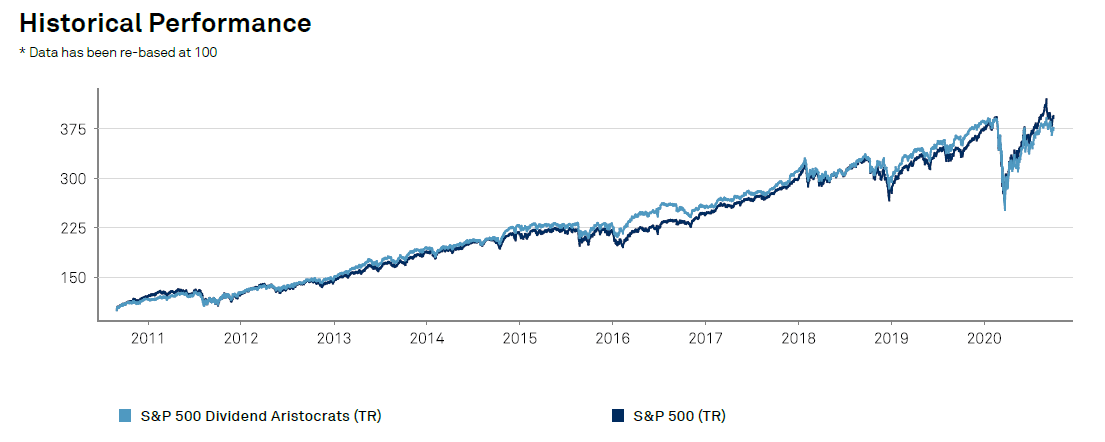- The Dividend Aristocrats are a select group of currently 65 S&P 500 stocks with 25+ years of consecutive dividend increases.
- These 65 are large, US companies that have historically provided (slightly) better performance and (slightly) lower volatility than the S&P 500 as a whole.
- By showing the recent performance of the Dividend Aristocrats, some active dividend growth investors may be able to identify relative bargains.
US equities struggled in September but managed to end the third quarter with gains. The S&P 500 gained another 9% last quarter, after losing 3.8% in September. The Dividend Aristocrats ended this month down -1.39% and are up 7.8% for the last three months. The investors were more optimistic after the Fed stimulus in the first part of this quarter and struggled with COVID-19 and related unemployment rates uncertainty again last month.
Dividend aristocrats underperforming
Year-to-date the US Dividend Aristocrats are still down -2.6% underperforming the S&P 500, given the +5.57% for this benchmark. One of the reasons is the allocation of Tech/IT, which is only 1.4% in the US Dividend Aristocrats index. Which is nothing compared to the +28% IT in the S&P 500 index.
 The 10 years annualized total returns of the Dividend Aristocrats and the S&P 500 are almost alike with 13.95% for the aristocrats and 15.06% for the SPX.
The 10 years annualized total returns of the Dividend Aristocrats and the S&P 500 are almost alike with 13.95% for the aristocrats and 15.06% for the SPX.
 Dividend Aristocrats performance in September 2020
Dividend Aristocrats performance in September 2020
The table below lists all 63 constituents, excluding the added spin-offs Carrier Global (CARR) and Otis Worldwide (OTIS), with indicated dividend yield and lists returns over trailing last month, 3-, 6-, and 12-month periods.
Key takeaways from September’s performance:
- 23 dividend aristocrats generated a positive, while 16 aristocrats lost more than 5% this month.
- Exxon Mobil and Chevron traded 14% lower, as revenue and earnings outlook remains weak due to a troubled oil market.
- Exxon Mobil’s dividend yield is now above 10%.
Year-to-date the top-3 best performing dividend aristocrats are still Clorox (CLX), S&P Global (SPGI), and Lowe’s Companies (LOW). The table below lists the best-performing stocks for this month.
A typical pattern shows up when looking at the year-to-date performance and dividend yield. “High yielders” are year-to-date the laggards while the low dividend yield aristocrats tend to have a positive performance compensating the missed dividend yield.
The table below lists the worst-performing stocks for this month.
The average dividend yield is 2.9% for all dividend aristocrats, below the top-10 highest-yielding aristocrats.
The above-presented performance data of the Dividend Aristocrats could assist active dividend growth investors to find some bargains for the long run. Interested in the latest data and also dividend growth rates, check our dividend aristocrats dashboard.
Other Sources of Dividend Investment Ideas
The Dividend Aristocrats list is not the only way to quickly screen for businesses that regularly pay rising dividends.
- The Dividend Kings List is even more exclusive than the Dividend Aristocrats. It is comprised of less than 20 businesses with 50+ years of consecutive dividend increases.
- The MoneyInvestExpert Defensive Aristocrats is a performance-based top-10 selection of the Dividend Aristocrats to outperform the market on the long-term.
- Portfolio lists like the Berkshire Hathaway Portfolio or Bill Gates’stock portfolio can be a source.
- For the European focused investors there is also the list of European Dividend Aristocrats.
- Dividend Champions are not necessarily members of the S&P 500 index, have increased their dividend for 25 or more consecutive years.
- 100+ years of dividend, the list of stocks that pay over 100 year of dividend can be an list of inspiration.
Next to selecting the right dividend stocks, important principles for successful long-term investing are Disciple, Diversification, Defensive & indeed Dividend. Read more about this in our free e-book.
Thanks for reading this article.
Please send any feedback, corrections, or questions to service[@]moneyinvestexpert.com.









